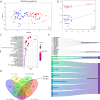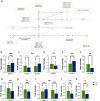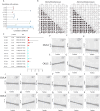Serum lipid profiling reveals characteristic lipid signatures associated with stroke in patients with leukoaraiosis
- PMID: 39733101
- PMCID: PMC11682383
- DOI: 10.1038/s41598-024-82808-7
Serum lipid profiling reveals characteristic lipid signatures associated with stroke in patients with leukoaraiosis
Abstract
Many lipid biomarkers of stroke have been identified, but the lipid metabolism in elderly patients with leukoaraiosis remains poorly understood. This study aims to explore lipid metabolic processes in stroke among leukoaraiosis patients, which could provide valuable insights for guiding future antithrombotic therapy. In a cohort of 215 individuals undergoing MRI, 13 stroke patients were matched with controls, and 48 stroke patients with leukoaraiosis were matched with 40 leukoaraiosis patients. Serum lipidomics was profiled using UPLC-TOF, and OPLS-DA was applied for metabolite identification. Partial Least Squares Path Model (PLS-PM) assessed pathway weights of novel metabolites in stroke risk, while linear regression explored correlations with clinical outcomes. Lipid profiling identified 168 distinct compounds. From these, 25 lipid molecules were associated with glycerolipid, glycerophospholipid, and sphingolipid metabolism. PLS-PM identified 12 key metabolites, including DG 36:4 (OR = 6.40) as a significant risk factor. Metabolites such as PE 38:5 and FA 16:1;O showed significant correlations with stroke in leukoaraiosis, particularly when the Fazekas score was ≥ 4. Twelve metabolites were identified as key factors in stroke incidence among leukoaraiosis patients. Lipid disturbances in glycerolipids and glycerophospholipids provide valuable insights for further studies on the progression from leukoaraiosis to stroke.
Keywords: Leukoaraiosis; Lipidomics; Metabolic pathway; Plasma; Stroke.
© 2024. The Author(s).
Conflict of interest statement
Declarations. Competing interests: The authors declare that the research was conducted in the absence of any commercial or financial relationships that could be construed as a potential conflict of interest. Ethics approval and consent to participate: This study was reviewed and approved by the Ethics Committee of the Sanming First Hospital Affiliated with Fujian Medical University (Ethics Approval Number: 2022–44). The participants provided written informed consent to participate in this study. Consent for publication: Before participating in the study, all participants signed up with informed permission.
Figures







References
-
- Tang, X. et al. Leukoaraiosis and acute ischemic stroke. Eur. J. Neurosci.54, 6202–6213 (2021). - PubMed
-
- Curtze, S. et al. Cerebral computed tomography-graded white matter lesions are associated with worse outcome after thrombolysis in patients with stroke. Stroke46, 1554–1560 (2015). - PubMed
-
- Ryu, W. S. et al. Grading and interpretation of white matter hyperintensities using statistical maps. Stroke45, 3567–3575 (2014). - PubMed
Publication types
MeSH terms
Substances
Grants and funding
LinkOut - more resources
Full Text Sources
Medical

